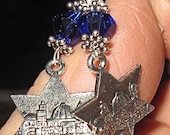'Sapphire for September' by Goofingoff
Sapphire is the birthstone for the month of September. Here's a sampling from the talented members Team Etsy Chai. Enjoy!
 Serenity Mermaid Sewing...
$12.00
|  ESHET CHAYIL blue cryst...
$85.00
|  Blue Kippah / Yarmulke ...
$25.00
|
 Jewish Menorah Earring...
$11.17
|  Torah Mezzuzah Case
$72.00
|  Hand Dyed Silk Wrap Bra...
$32.00
|
 Tallit clips in Pinks &...
$38.00
|  Swarovski Crystal and P...
$6.50
|  Aba Mug for Dad
$23.00
|
 Vintage NOS 7" Pew...
$19.99
|  Jacob's Star
$27.00
|  lapis lazuli crinkle ea...
$88.88
|
 Pomegranate Ear Clips -...
$350.00
|  Magen David crystal and...
$30.00
|  Esther Necklace Hamsa H...
$50.00
|
 Star of David Jerusalem...
$19.95
|
Treasury tool supported by the dog house










